Do you have a 1776 to 1976 Silver Dollar? If you do, you may be wondering what its value is. While the answer to that question can vary depending on a number of factors, such as the condition of the coin, generally speaking, these coins are worth quite a bit of money. In fact, some collectors are willing to pay hundreds or even thousands of dollars for one!
So if you have one (or more) of these coins sitting around, it might be worth your while to take a closer look at it and see how much it could be worth. Who knows? You could end up with a nice chunk of change in your pocket!
What is a 1776 to 1976 Silver Dollar?
In 1976, the United States Mint released a special coin to celebrate the bicentennial of the United States. The Bicentennial of the United States was a celebration commemorating the 200th anniversary of the country’s independence. The bicentennial was an opportunity for Americans to reflect on their country’s past and to celebrate its achievements.
The 1776 Eisenhower dollar was designed by a young art student, Dennis R. Williams. The coin’s obverse side featured the same design of President Dwight D. Eisenhower as coins from previous years, while the reverse side featured the Liberty Bell and the moon. The coin’s double date of 1776-1976 was intended to represent the country’s past and future. This is also the last year that Eisenhower dollars were minted.
Dwight D. Eisenhower was an important figure in American history. He served as the 34th president of the United States from 1953 to 1961, and led the country through a period of economic prosperity and Cold War tensions. As such, Dwight D. Eisenhower was a crucial leader during a pivotal time in American history. Through his actions, he helped to shape the country into what it is today.
1976 Type I vs. Type II Clad Dollar Coins
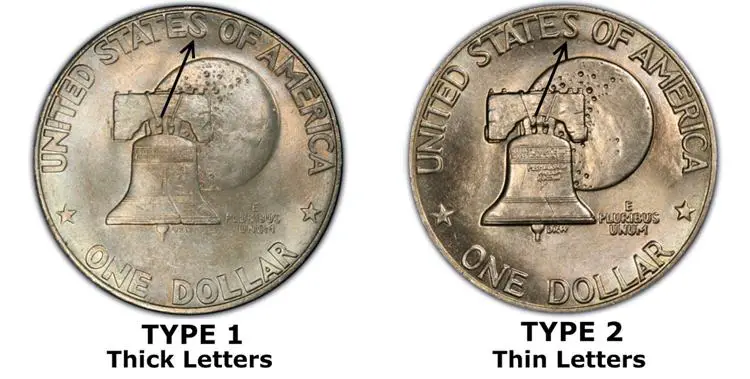
The Mint produced two types of clad dollar coins – Type I and Type II. The main difference between the two is the lettering on the tail’s side of the coin. Type II dollars have crisper, more refined lettering than their Type I counterparts. They are also much more common, which is why you’re likely to see more of them in circulation. So, if you’re ever lucky enough to find a 1976 dollar coin, be sure to check the lettering
How Rare is a 1776 to 1976 Silver Dollar?
Many people believe that all 1776-1976 Eisenhower dollars are silver coins. However, this is not the case. With a little research, it’s easy to tell the difference between the two types of coins and avoid paying too much for a base metal coin masquerading as a silver dollar.
Here’s an overview of the numerous Eisenhower Dollars and their mintages from 1776 to 1976:
Series |
Mintages |
1776-1976, Copper-Nickel Clad Type 1 |
4,019,000 |
1776-1976, Copper-Nickel Clad Type 2 |
113,318,000 |
1776-1976 D, Copper-Nickel Clad Type 1 |
21,048,710 |
1776-1976 D, Copper-Nickel Clad Type 2 |
82,179,564 |
1776-1976 S, Copper-Nickel Clad Type 1 Proof |
2,845,450 |
1776-1976 S, Copper-Nickel Clad Type 2 Proof |
4,149,730 |
1776-1976-S, 40% Silver Uncirculated Type 1 |
11,000,000 |
1776-1976-S, 40% Silver Proof Type 2 |
4,000,000 |
A lot of silver dollar coins were melted after 1982, which means their real number is much lower than reported.
How to Know if You Have a Real Silver Dollar Coin?
Many people don’t know the difference between a copper-nickel coin and a silver coin. Here are a few things to look for when trying to tell the difference. First, Eisenhower silver dollars usually have a little S mint mark between Ike’s portrait and the date. Also, silver coins will generally look shinier than copper-nickel coins. This is because silver is a much more reflective metal than copper.
Second, silver coins will also generally weigh more than copper-nickel coins. This is because silver is a denser metal than copper. A silver coin weighs 24.59 grams, while a copper-nickel coin only weighs 22.68 grams. Finally, you can also tell the difference by the sound that the coin makes when it is dropped on a hard surface. Silver has a higher sound conductivity than copper, so a silver coin will make a higher-pitched sound when dropped than a copper-nickel coin.
Eisenhower Dollar Grading Scale
When it comes to collectible coins, there are many factors that can affect their value. One of the most important is the condition of the coin.
The Sheldon Scale is the most common way to numismatically grade United States coins. Coins are graded on a scale of 1 to 70, with 1 being the lowest grade and 70 being the highest. The Sheldon Scale is an important tool for numismatists because it provides a consistent way to evaluate coins. When two people are looking at the same coin, they can use the Sheldon Scale to agree on its value.
When it comes to Eisenhower silver dollars, there are some grades that are most valuable:
- MS 63: There are some flaws or touch marks in the main focal areas. The luster of the coin may not be as noticeable as it once was.
- MS 65: There is a lot of sparkle and charm to it. There may be a few light contact marks, but they are scarcely discernible.
- MS 69: There are no more than two little non-detracting contact marks or blemishes on the coin, which has a sharp strike and full original shine.
- PR 65: Proof coin. This coin contains no defects. A few minor flaws are possible.
- PR 70: A rare proof coin with zero imperfections. The visual appeal is outstanding.
Whether you’re an experienced collector or just getting started, familiarizing yourself with the Sheldon Scale is a good way to ensure that you’re always getting the most out of your hobby.
What is the 1776 to 1976 Dollar Value?
Before we take a closer look at the silver Ike dollar coin values, let’s take a look the regular bicentennial dollars.
1976 Type I Clad Dollar Coin Value
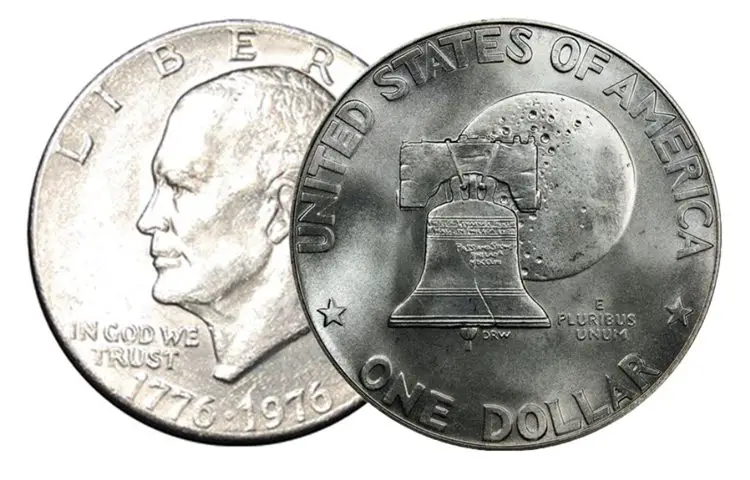
The Type I clad dollar was minted at the Philadelphia Mint, with a total of 4,019,000 being produced. These coins do not have a mintmark, and are typically worth around $2 in circulated condition and $10 to $20 in uncirculated grade.
However, if the coin has an error, it can be worth significantly more. The most expensive Type I clad dollar sold for an amazing $28,200, as it was overstruck with a 1976 Bicentennial Quarter. Of course, these are really rare examples and most Type I clad dollars won’t be worth that much.
The San Francisco Mint produced 2,845,450 Type I 1976 S Bicentennial dollar coins. Most of these coins are worth $10 to $15 in perfect condition. However, one coin recently sold for $25,300. The coin was graded by Professional Coin Grading Service as being in perfect condition. It is believed that there are only a handful of these coins in existence in such pristine condition.
Let’s take a look at some of the more common examples sold recently on eBay:
- A 1976 D Eisenhower dollar coin minted in Philadelphia sold for $16.
- A similar coin sold for $14, but it slightly worse condition.
- A set of Type I and Type II Eisenhower dollars sold for $37.
1976 Type II Clad Dollar Coin Value
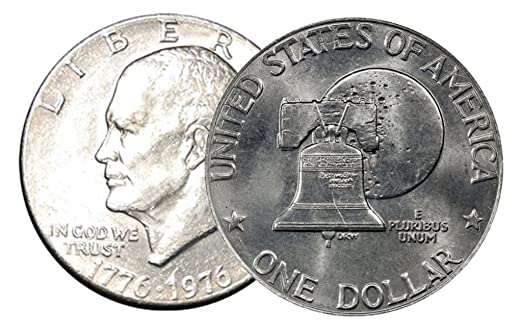
These coins are worth around $1, but can be worth $4 to $10 in uncirculated condition. Interesting errors can raise the price tag, for example a double struck coin sold for $8,050 in 2007. So, if you come across one of these coins, it might be worth taking a closer look!
The D Type II dollar has the same price. It has the mint mark D on the obverse, which signifies that it was made at the Denver Mint. These coins are worth around $1, but uncirculated pieces can take $4 to $10. The most expensive one was sold for $3,600, but these are one-of-a-kind examples.
The 1976 S Type II clad proof dollar coin is a highly sought after collector’s item, with a limited mintage of just over four million coins. These coins are now worth between $8 and $12 dollars each, depending on condition. The most expensive coin in perfect condition has sold for over $20,000.
Let’s take a look at some of the more common examples sold recently on eBay:
- A 1976 S Type II Eisenhower dollar sold for a little over $20.
- A circulated 1976 dollar coin sold for around $3.
- A 1976 S Type 2 clad proof dollar coin sold for $8.
What is the 1776 to 1976 Silver Dollar Value?
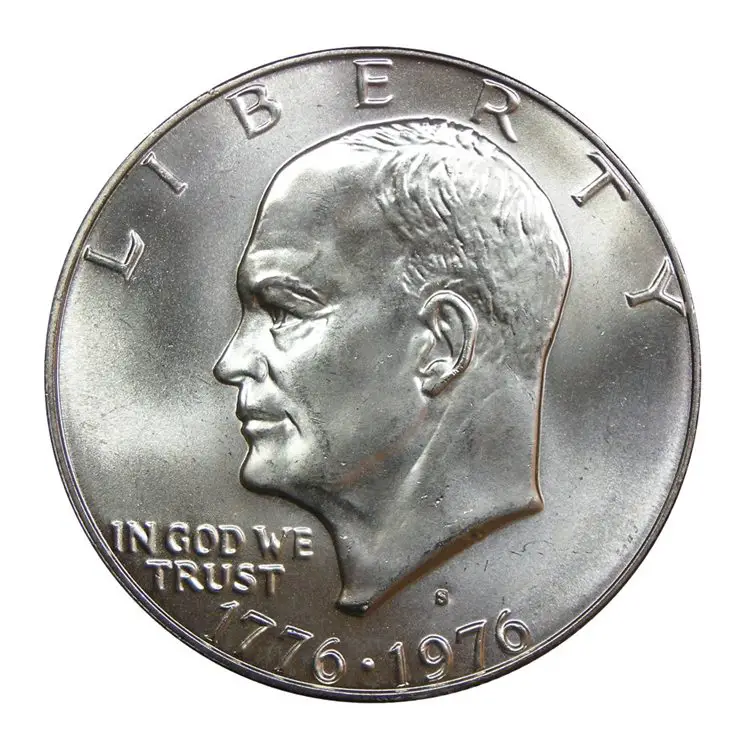
This coin is made of silver, which means that it is worth at least its weight in silver. The silver melt value for this coin is $6.92 as of June 2022. This means that even if the coin is in poor condition, it is still worth at least $6.92.
While most Bicentennial silver dollars are worth around $12 to $15, some coins in pristine condition can be worth hundreds or even thousands of dollars. Errors can also add to the value of a coin, so collectors should be on the lookout for these rare gems.
Let’s take a look at some of the sold examples:
This coin was graded MS-69 by Professional Coin Grading Service (PCGS), meaning it is virtually flawless. It also exhibits what is known as “satin luster,” a highly desired trait among collectors. In addition, the coin’s design features are exceptionally well-defined, making it a truly outstanding example. Given its condition and attributes, it’s no wonder this coin sold for $4,560.
In 2011, a 1976-S dollar coin sold for $3,737. This coin is a non circulating Type I Silver Proof PR70, which is a very rare type of coin. The coin’s surfaces are perfect and there are no flaws, even when examined under a microscope. A similar coin sold for half the price a few years later.
What is the Most Expensive Eisenhower Silver Dollar Sold?
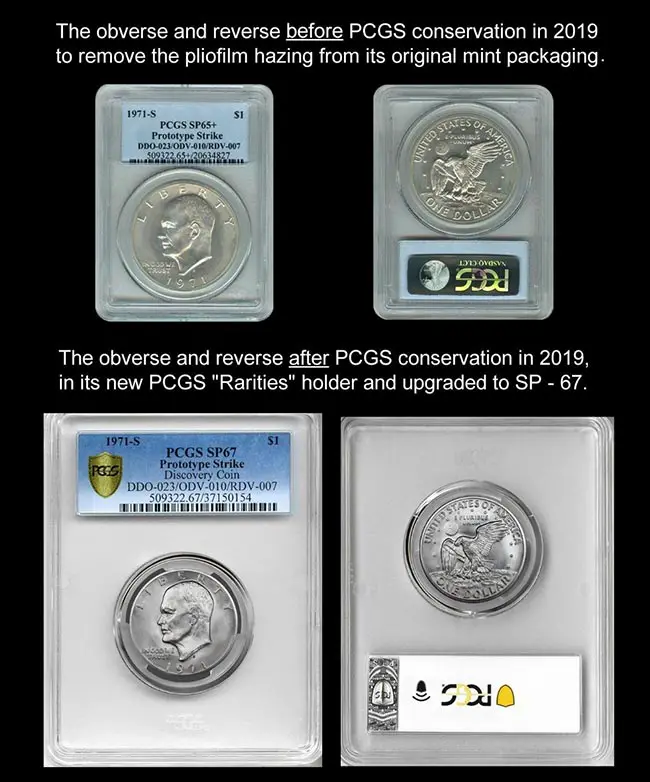
The most expensive Eisenhower dollar coin is a 1971 S $1 Eisenhower Dollar Prototype. Its one of three known working prototypes. Sold for $264,000 on Heritage Auctions. This makes it the most expensive Eisenhower dollar coin ever sold!
A prototype coin is a sample of a proposed coin design. They are usually minted in small quantities and are not circulated. Prototype coins are often created as part of the process of designing a new coin, and they can be used for testing or for promoting the new design.
The coin pictured is a stunning example of high relief medallic art, with beautiful doubling evident on the motto and date. This coin was graded SP-67 (Specimen) by Professional Coin Grading Service and labeled as “Discovery Coin”, signifying its rarity and desirability. It is truly a collector’s item and would make an excellent addition to any collection.
Where to Sell 1776 to 1996 Eisenhower Silver Dollars
Eisenhower silver dollars are some of the most popular coins among collectors, and they can be quite valuable. If you have a 1776-1996 Eisenhower silver dollar, you may be wondering where to sell it.
Heritage Auctions is generally considered to be the best option for selling Eisenhower silver dollars. They have a large network of potential buyers, and they are able to get top dollar for coins in perfect condition or with errors.
Ebay is another great option. This online marketplace is a popular destination for coin collectors, and you can reach a wide audience of potential buyers by listing your coins here. Plus, eBay makes it easy to set up your listings and track your sales.
Another option is to sell them through a local coin dealer. Coin dealers typically have a knowledge of the Eisenhower dollar market and can offer guidance on pricing and marketing the coins. Apmex is a great website that can help you find coin dealers near you.
Finally, bicentennial dollar coins can also be sold directly to collectors. This option allows for the greatest degree of control over the sale, but it may be more difficult to find interested buyers. You can find collectors on dedicated forums like the Coin Talk and the Coin Community.
Tips for Selling 1776 to 1996 Eisenhower Silver Dollars
If you have 1996 Eisenhower silver dollars to sell, there are a few things you can do to maximize your profits:
- Make sure that your coins are in good condition. Uncirculated or proof coins will be worth more than those that have been circulated.
- You can also have your coin encapsulated in plastic; this protects the coin and makes it easier to store and display.
- Have your coins professionally graded by a reputable company such as NGC or PCGS. Graded coins will always sell for a premium over non-graded coins.
- Make sure to take good quality photos of the coins. Include close-ups of both the front and back sides, as well as any interesting details that may be visible.
- Provide as much information as possible about the condition of the coins and any history or provenance that they may have.
By following these tips, you’ll be well on your way to making a successful sale.
FAQ
Which Eisenhower dollars are 90% silver?
The limited-edition Eisenhower Centennial Proof Silver Dollar is the only Eisenhower dollar that is 90% silver. This coin was created to commemorate Dwight D. Eisenhower’s birth on his 100th birthday and features a portrait of Ike on both sides of the coin.
What is the Composition of 1776 to 1996 Silver Dollar?
The composition of the 1776 to 1996 silver dollar is 60% copper and 40% silver. The silver weight is .3161 oz, and the total weight of the coin is 24.59 grams.
Are all 1776 to 1976 Eisenhower dollars 40% silver?
While most of these bicentennial dollar coins were struck in copper-nickel, only a small number were made with silver.
What Makes 1776 to 1996 Silver Dollars Valuable?
Just like any other coin, the value of a silver dollar is based on a number of factors, including rarity and condition. Generally speaking, the rarer the coin, the higher its value will be. The same is true for coins in good condition – those that have been well preserved will typically be worth more than those that have been damaged or show signs of wear and tear.
Where is the mint mark on a 1776-1976 silver dollar?
The mint mark on a 1776-1976 silver dollar is located on the obverse, beneath Eisenhower’s bust. The mint mark indicates which USA Mint produced the coin. Coins from the Philadelphia Mint do not have a mint mark, while those from the Denver Mint have a D mint mark. The San Francisco Mint produced some of these dollars for special collector sets, and those coins have an S mint mark.
Final Thoughts
In 1976, the United States Mint released a special dollar coin to celebrate the bicentennial of the United States. While regular circulated coins aren’t worth much, silver coins are minted in limited numbers and can be worth a lot.
The value of a 1776 to 1976 silver dollar depends on several factors, including the condition of the coin and the current market price for silver. In general, most bicentennial silver dollars are worth around $12 to $15, but some coins in pristine condition can be worth hundreds or even thousands of dollars. As a result, the value of Eisenhower dollars can vary significantly depending on its individual characteristics. Thanks for reading!

Michelle Greene
Tuesday 15th of November 2022
I have a Eisenhower silver dollar type 2 that's in good condition. Would like to sell.
Thanks
Michelle